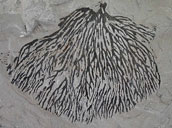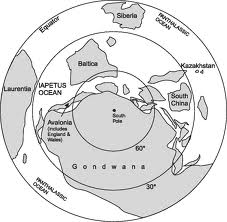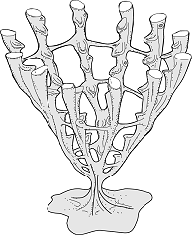The first graptolites appeared in the Upper Cambrian period in the form of the order Dendroidia. The Dendroids are the oldest Graptolites in the fossil record.(McNamara 2014) The Dendroids lived in colonies that were comprised of several individuals, zooids, which were connected to each other by a common nervous system.(www2) The Dendroids were mostly comprised of sessile benthic filter feeders that were attached to the sea floor by a root-like holdfast system. During the Upper Cambrian and the Lower Ordovician periods species from the order Dendroidia evolved into new species of free flowing planktonic filter feeders. These pelagic species of Dendroids then continued without much further development until their extinction in the Upper Carboniferous period. The pelagic Dendroids are believed to have been a key evolutionary step in the formation of the most diverse and successful Graptolites, the order Graptoloidia.(Rickards 1978)
The Graptoloids first appeared during the Lower Ordovician period and were by far the most successful, diverse and widespread order of Graptolites. The Graptoloids used the ocean currents to spread to new areas around the world and today their fossils can be found on every continent except Antarctica.(McNamara 2014) The Graptoloids went through a period of rapid evolution which started in the Lower Ordovician period and continued until the Upper Silurian period. This time of rapid evolution allowed the Graptoloids to quickly adapt to new niches and habitats and was a key factor in their global success.(Rickards 1978)
Each graptolite colony, known as a rhabdosome has a variable number of branches called stripes. The colony originates from an initial conical cup called a sicula from which the whole colony develops. Each individual zooid was housed within a cup like structure called a theca. The number of branches and the arrangement of the thecae are important features in the identification of the graptolite fossils. The orders Graptoloidea and Dendroidea are generally distinguished by the number of branches on the colony with the Dendroids having more branches than the Graptoloids. The most notable changes seen as the Graptoloids evolved were seen in the number of stripes per colony along with a change in the attitude of the stripes. These changes coincided with an increase in the complexity and change in the positioning of the thecae.(Rickards 1978)
Graptolite fossils are most commonly found in deep water black shales but are also found in shallower conditions. Most of the Graptolite fossils found are carbonised. The process of carbonisation along with the easily compressed shales has made most graptolite fossils flat and therefore very difficult to study. This has made studying the evolution of the graptolites very difficult but much information has still been pieced together using the help of three dimensional fossils that have been infilled with iron pyrite. (www1)
References:
- R.B Rickards , Major aspects of evolution of the Graptolites. Acta Palaeontologica Polonica, Vol. 23 Pg. 585.
- (www1) http://www.graptolite.eu/about.htm
- (www2)http://www.oldearth.org/curriculum/history/earth_history_c5_silurian_graptolites.htm
- UCC Blackboard. Maria McNamara, 2014. Graptolites Lecture notes.









